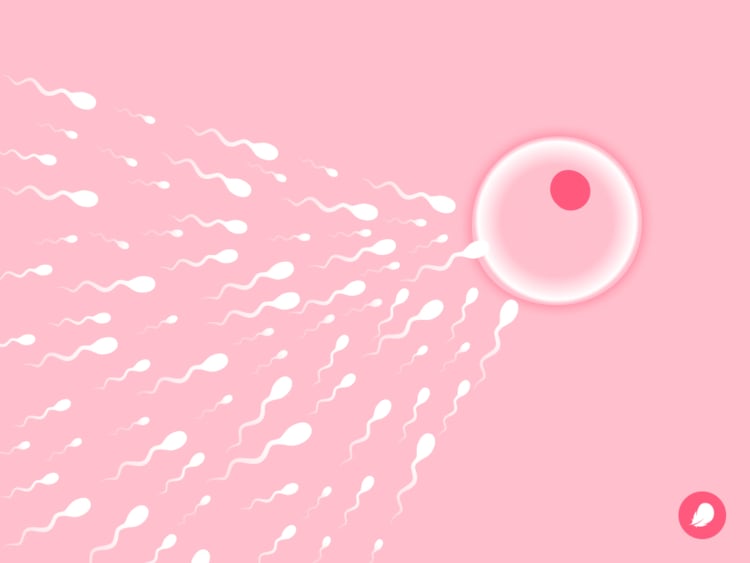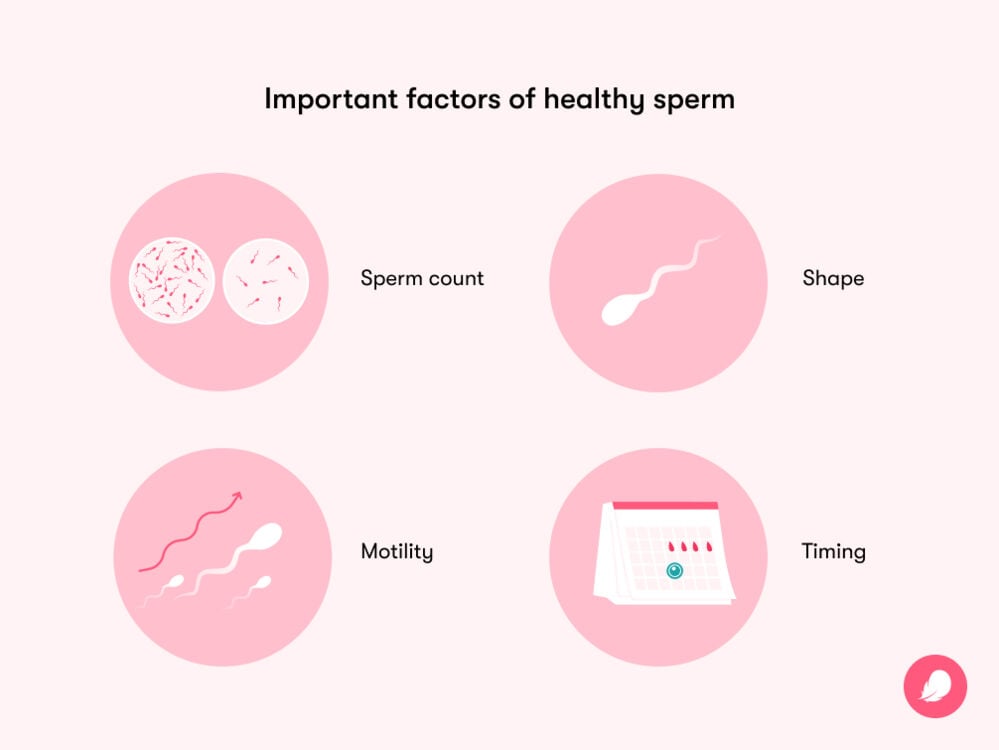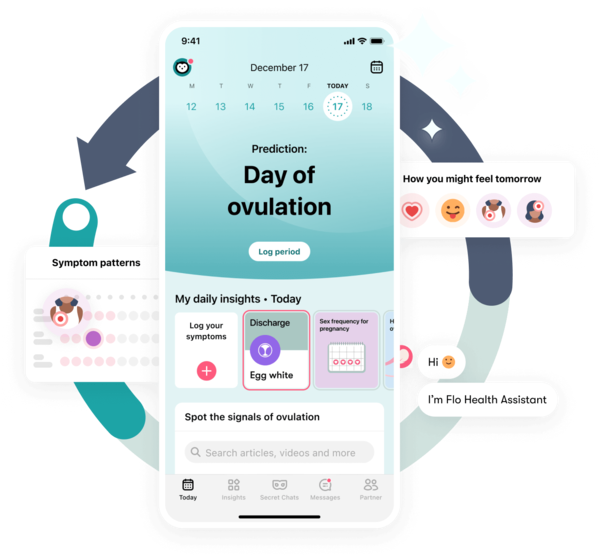Wondering what matters when it comes to the amount of sperm you need to get pregnant? Read on to figure out how to improve your conception chances.
-
Tracking cycle
-
Getting pregnant
-
Pregnancy
-
Help Center
-
Flo for Partners
-
Anonymous Mode
-
Flo app reviews
-
Flo Premium New
-
Secret Chats New
-
Symptom Checker New
-
Your cycle
-
Health 360°
-
Getting pregnant
-
Pregnancy
-
Being a mom
-
LGBTQ+
-
Quizzes
-
Ovulation calculator
-
hCG calculator
-
Pregnancy test calculator
-
Menstrual cycle calculator
-
Period calculator
-
Implantation calculator
-
Pregnancy weeks to months calculator
-
Pregnancy due date calculator
-
IVF and FET due date calculator
-
Due date calculator by ultrasound
-
Medical Affairs
-
Science & Research
-
Pass It On Project New
-
Privacy Portal
-
Press Center
-
Flo Accuracy
-
Careers
-
Contact Us
How much sperm does it take to get pregnant?


Every piece of content at Flo Health adheres to the highest editorial standards for language, style, and medical accuracy. To learn what we do to deliver the best health and lifestyle insights to you, check out our content review principles.
We all know the basics of conception. It’s the marrying together of egg and sperm. But if you’re trying to get pregnant — particularly if you’ve been trying for some time — you might want a little more detail about the process.
For instance, does it really take just one little sperm to get pregnant? And, if so, why does “low sperm count” sometimes signal a problem for couples trying to conceive? Obstetrician and gynecologist Dr. Charlsie Celestine from New Jersey, US, is here with the lowdown.
Key takeaways
- Technically, it only takes one sperm to get pregnant. But the chances are higher when your partner’s ejaculate contains at least 15 million sperm per milliliter.
- Only a fraction of the sperm in semen is healthy enough to make it all the way to the egg for fertilization.
- Timing is really important if you’re trying to conceive. Pregnancy chances are at their highest during your fertile window (about six days per cycle around ovulation).
- It’s not all about numbers. Sperm movement and shape can also play a role in your pregnancy chances.
- Living an active and balanced lifestyle can increase sperm health, so there might be some tweaks your partner could make to improve your chances of getting pregnant.
How much sperm is needed to get pregnant?
Sperm meets egg. Right? In theory, just one sperm is all that’s required to get pregnant. But it’s a little bit more complicated than that.
“I wish more people knew that the male factor is as important as the female factor for fertility and pregnancy,” says Dr. Celestine.
Fertilization generally involves millions of sperm. There are typically around 15 million to 200 million sperm per milliliter of semen (that’s the white fluid that comes out of your partner’s penis when they ejaculate).
Even a large amount of semen won’t necessarily result in a positive pregnancy test though. Research shows that only a fraction of the sperm in a single ejaculation are healthy enough to make a baby.
Timing conception sex is, of course, vital too. Even the strongest sperm can’t fertilize an egg if it isn’t there. Your chances of pregnancy are highest during your fertile window (which happens around ovulation, when your ovaries release an egg). An ovulation-tracking app like Flo can help you learn more about your fertile window and ovulation signs (though remember, Flo’s predictions shouldn’t be used as a conception aid).
Can you get pregnant from just a few drops of semen?
You know now that semen contains a lot of sperm. But does that mean you can get pregnant from just a few drops of it? Technically, the answer is yes, as just one sperm is all it takes. So if semen has been in contact with your vagina, pregnancy is possible, as even a tiny amount of semen can contain thousands of sperm, says Dr. Celestine.
If you don’t want to get pregnant, you should use a reliable method of contraception. Some people prefer the “pullout” or withdrawal method (where your partner pulls their penis out of your vagina before they orgasm). But it’s not a super reliable approach. Just over 1 in 5 people get pregnant using the withdrawal method every year.
This is why it’s not always foolproof: When your partner is sexually aroused (but before they ejaculate), the penis produces a liquid called pre-ejaculate (or precum). This fluid doesn’t technically contain any living sperm, but it could mix with some during sex. One 2013 study found that 41% of men had traces of live sperm in their precum. So some sperm could find its way toward your egg, even if your partner hasn’t ejaculated inside you.
What sperm characteristics are important for getting pregnant?
It’s not all about numbers. There are a few other factors that are important when it comes to healthy sperm for getting pregnant, says Dr. Celestine. “But I can’t say I know which factor is the most critical, as they all play an important role.”
Remember, there are lifestyle changes that can be made to help all of the following:
Sperm count
Chances of pregnancy drop with a lower sperm count. Doctors consider a low sperm count to be less than 15 million sperm per millimeter of ejaculate. It’s not a deal-breaker, though. Many people with low sperm counts go on to have children. And it works the other way around, too. Even if your partner has plenty of sperm, there are other factors that can impact fertility.
Sperm motility (movement)
To get to the egg, sperm have to wriggle through your cervix, uterus, and fallopian tubes. This is known as sperm motility. Even if your partner has a healthy sperm count, pregnancy chances will only be high if a good number of those sperm can move well.
Research shows that around 40% of sperm in semen needs to be able to swim for the best chances of pregnancy. Getting pregnant isn’t impossible if motility is below this number, but it does make it trickier.
Shape
How sperm are shaped also plays a role in getting pregnant. Normal sperm have an oval head with a long tail. This launches them forward while they swim toward the egg. Sperm with a misshapen head or crooked tail can find it harder to reach and fertilize the egg.
That said, having a large percentage of misshapen sperm is actually pretty common. On average, only around 4% to 10% of the sperm in a semen sample look perfect under a microscope.
Timing
As mentioned already, timing is key when you’re trying to conceive. Even with the healthiest sperm, pregnancy is unlikely (though not impossible) to happen outside your fertile window.
You’re fertile for about six days in your cycle around ovulation. Not sure of the science behind it? Sperm can live in your body for as long as five days, while an egg can survive for 12 to 24 hours after ovulation. So having sex up to five days before ovulation or one day after is when pregnancy chances are highest.

Can you increase sperm count to improve your chances of pregnancy?
If your partner is worried about their sperm, the best thing to do is speak to their health care provider. They will be able to analyze a semen sample and suggest next steps from there.
There are also a few lifestyle tweaks that might help them produce more semen, such as:
Maintaining a healthy weight
A higher body mass index (BMI) has been linked to a lower sperm count and reduced sperm movement. Your partner can chat with their doctor about what a healthy weight looks like for them if they’re not sure.
Eating healthily
Fruits and vegetables are rich in antioxidants, which are good for you, so getting a good number of these is always a good idea. Plus, research suggests they might help improve sperm health.
Getting an STI check
Sexually transmitted infections like chlamydia and gonorrhea can impact fertility, so it’s worth getting tested and treated if necessary before you start to try to conceive.
Managing stress
Stress might mess with the hormones needed to produce sperm. Finding ways to manage stress that work for your partner can be a great help, especially as trying to conceive can be stressful in itself. Try to keep open communication and make time for things you both enjoy as a way of relieving stress.
Staying active
Regular exercise is a good idea for all around health. But it can also boost levels of antioxidant enzymes, which help protect sperm.
Take a quiz
Find out what you can do with our Health Assistant
Don’t be afraid to get your partner’s sperm tested
Sperm health matters for getting pregnant, so it’s a topic you and your partner might want to explore with your doctor if you’ve been trying to conceive for a little while.
“Many men are scared to get tested or think the female partner should be tested first. But there’s no shame in testing the male partner, and it should be done early on if there’s a fertility concern,” says Dr. Celestine.
Remember, a low sperm count doesn’t mean pregnancy is impossible. And there are plenty of treatments that can help. Your doctor can advise on the most appropriate options. If you want to make getting pregnant more of a team effort by helping your partner to understand more about your cycle, explore Flo for Partners on the Flo app.
Frequently asked questions about sperm and getting pregnant
How deep does sperm have to go to get you pregnant?
Sperm tend to be excellent swimmers, so they don’t need to reach too deep inside the vagina for you to get pregnant. They can travel from near your vaginal entrance through the cervix and into your fallopian tubes to meet an egg. It doesn’t take much time for sperm to reach the egg — we’re talking minutes in some cases. So even if just the tip of the penis goes into your vagina, pregnancy is still possible.
How long should sperm sit inside you to get pregnant?
Sperm don’t need to “sit” inside you for a specific amount of time, as they can survive for quite a few days all on their own. What’s important if you’re looking to get pregnant is timing sex around ovulation. Your fertile window generally includes the five days before and one day after ovulation. So there are roughly six days per cycle when your pregnancy chances are highest. Having unprotected sex during this time will give you the best chance of getting pregnant.
What are the signs that a man is fertile?
You can’t tell whether a man is fertile or not just by looking. If you’re having trouble conceiving, a fertility doctor might suggest tests to look at your partner’s sperm health under a microscope. They’ll explore a few factors such as sperm count, motility, and shape and will get a better idea of what treatment, if any, could help.
It’s recommended that you book an appointment if you’re under 35 and have been trying for over a year without any luck. If you’re over 35, see your doctor if it’s been more than six months, and if you’re over 40, it’s best to go right away. But try to remember that it can take some time to conceive even if there are no fertility issues. Within one year of trying, 85% of couples get pregnant.


Hey, I'm Anique
I started using Flo app to track my period and ovulation because we wanted to have a baby.


The Flo app helped me learn about my body and spot ovulation signs during our conception journey.


I vividly
remember the day
that we switched
Flo into
Pregnancy Mode — it was
such a special
moment.
Real stories, real results
Learn how the Flo app became an amazing cheerleader for us on our conception journey.
References
“Abnormal Sperm Morphology: What Does It Mean?” Mayo Clinic, 21 Dec. 2022, www.mayoclinic.org/diseases-conditions/male-infertility/expert-answers/sperm-morphology/faq-20057760.
Alberts, Bruce, et al. “Fertilization.” Molecular Biology of the Cell. 4th ed., Garland Science, 2002.
Cooper, Trevor G., et al. “World Health Organization Reference Values for Human Semen Characteristics.” Human Reproduction Update, vol. 16, no. 3, May 2010, pp. 231–45, https://doi.org/10.1093/humupd/dmp048.
Custers, Inge M., et al. “Immobilisation versus Immediate Mobilisation after Intrauterine Insemination: Randomised Controlled Trial.” BMJ, vol. 339, Oct. 2009, https://doi.org/10.1136/bmj.b4080.
“Effectiveness of Birth Control Methods.” The American College of Obstetricians and Gynecologists, Apr. 2023, www.acog.org/womens-health/infographics/effectiveness-of-birth-control-methods.
“Evaluating Infertility.” The American College of Obstetricians and Gynecologists, Jan. 2020, www.acog.org/womens-health/faqs/evaluating-infertility.
Ferramosca, Alessandra, and Vincenzo Zara. “Diet and Male Fertility: The Impact of Nutrients and Antioxidants on Sperm Energetic Metabolism.” International Journal of Molecular Sciences, vol. 23, no. 5, Feb. 2022, https://doi.org/10.3390%2Fijms23052542.
“Healthy Sperm: Improving Your Fertility.” Mayo Clinic, 13 May 2022, www.mayoclinic.org/healthy-lifestyle/getting-pregnant/in-depth/fertility/art-20047584.
“How to Get Pregnant.” Mayo Clinic, 11 Dec. 2021, www.mayoclinic.org/healthy-lifestyle/getting-pregnant/in-depth/how-to-get-pregnant/art-20047611.
Killick, Stephen R., et al. “Sperm Content of Pre-Ejaculatory Fluid.” Human Fertility, vol. 14, no. 1, Mar. 2011, pp. 48–52, https://doi.org/10.3109%2F14647273.2010.520798.
“Low Sperm Count.” Mayo Clinic, 17 Dec. 2022, www.mayoclinic.org/diseases-conditions/low-sperm-count/diagnosis-treatment/drc-20374591.
“Periods and Fertility in the Menstrual Cycle.” NHS, www.nhs.uk/conditions/periods/fertility-in-the-menstrual-cycle/. Accessed 9 Sep. 2024.
“Session 24: Ovulation and Fecundity.” Human Reproduction, vol. 25, no. suppl. 1, June 2010, pp. I37–38, https://doi.org/10.1093/humrep/de.25.s1.24.
Suarez, S. S., and A. A. Pacey. “Sperm Transport in the Female Reproductive Tract.” Human Reproduction Update, vol. 12, no. 1, Jan. 2006, pp. 23–37, https://doi.org/10.1093/humupd/dmi047.
Witt, Barry. “Trying to Get Pregnant? Here’s When to Have Sex.” The American College of Obstetricians and Gynecologists, Aug. 2023, www.acog.org/womens-health/experts-and-stories/the-latest/trying-to-get-pregnant-heres-when-to-have-sex.
History of updates
Current version (08 October 2024)
Published (14 June 2021)
In this article

Get your personal guide to fertility
-
Learn how to read your body's ovulation signals
-
Find daily conception tips from our experts
-
Chat with others who are trying to get pregnant




